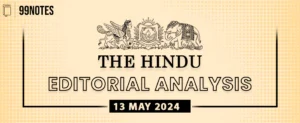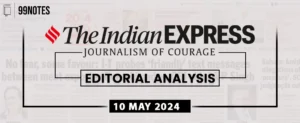Topic: GS3 – Environment – Conservations – Important species, GS3 – Environment – Environmental Pollution and Degradation Understanding Supreme Court’s recognition of climate rights and just transition framework is crucial for environmental jurisprudence and climate governance. |
| Context |
| ● The article discusses the Supreme Court’s recognition of a fundamental right against climate change impacts and advocates for the just transition framework for inclusive climate action. |
Supreme Court Judgment and Recognition of Climate Rights:
- The Supreme Court recognized a fundamental right to be free from the adverse impacts of climate change.
- The judgement addressed the protection of the critically endangered Great Indian Bustard, focusing on the impacts of renewable energy projects.
Limited Articulation of the Right:
- The Court refrained from articulating the right in detail, allowing space for future discourse and informed articulation.
- This departure from past practices signifies judicial restraint and promotes a more nuanced understanding of climate rights.
Just Transition Framework:
- The judgement framed biodiversity protection and climate action as competing choices, posing a challenge.
- Advocating for the just transition framework can reconcile these choices, ensuring equitable and inclusive climate action.
- This approach considers the interests of affected parties, including biodiversity conservation, in transitioning to a low-carbon economy.
Advantages of Using the Just Transition Framework:
- Prevents adversarial choices between biodiversity protection and climate action, fostering inclusive climate action.
- Facilitates the articulation of reflexive and inclusive climate rights, sensitive to non-human interests and ecological justice.
- Sets a precedent for just transition litigation considering non-human interests, contributing to expanding the concept globally.
Call for Shared Responsibility:
- The pending final decision presents an opportunity for the judiciary to apply the just transition framework.
- Stakeholders, including the state, activists, litigants, and academics, share the responsibility of shaping and enforcing climate rights.
Conclusion:
- The Supreme Court’s recognition of climate rights, coupled with the potential application of the just transition framework, offers a pathway for inclusive and equitable climate action in India.
- This shared responsibility underscores the need for collaborative efforts to articulate and enforce climate rights effectively.
| More about The Great Indian Bustard: |
● The Great Indian Bustard (Ardeotis nigriceps) is one of the heaviest flying birds found in the Indian subcontinent. ● It is listed as critically endangered by the International Union for Conservation of Nature (IUCN). ● Historically widespread across the Indian subcontinent, its population has drastically declined due to habitat loss, hunting, and collisions with power lines. ● The bustard prefers arid and semi-arid grasslands, dry savannahs, and open country with short grass or shrubs. ● Conservation efforts are focused in states like Rajasthan and Gujarat, where most of the remaining population is found. ●It faces numerous threats, including habitat fragmentation due to agriculture and infrastructure development. ● The species is known for its elaborate courtship displays during breeding season, which involve puffing up their chest, strutting, and emitting low booming calls. ● Conservation initiatives include habitat restoration, captive breeding programs, and measures to reduce mortality from power lines and human disturbance. ● The survival of the Great Indian Bustard is crucial for maintaining ecosystem balance and biodiversity in its native grassland habitats. |
| Fundamental right to be free from the adverse impacts of climate change: |
● Legal Precedent: The Supreme Court’s recognition of the fundamental right to be free from the adverse impacts of climate change establishes a significant legal precedent, affirming the importance of environmental protection and climate justice in India. ● Human Rights Perspective: This decision highlights the intersection of environmental rights and human rights, emphasising the right to a healthy environment as a fundamental aspect of the right to life and livelihood. ● Policy Implications: The ruling has far-reaching implications for environmental policy and governance, signaling the need for stronger regulatory frameworks, enforcement mechanisms, and climate action strategies to address climate change impacts and protect vulnerable communities. ● Judicial Activism: The Supreme Court’s proactive stance on climate change reflects judicial activism in advancing environmental justice and holding governments and corporations accountable for their actions or inaction in addressing climate-related risks and vulnerabilities. ● Global Recognition: The decision contributes to global recognition of the importance of legal mechanisms and judicial interventions in promoting climate resilience, adaptation, and mitigation efforts, setting a positive example for other jurisdictions grappling with similar challenges. ● Empowerment of Citizens: By recognizing the fundamental right to be free from the adverse impacts of climate change, the Supreme Court empowers citizens to demand accountability, transparency, and action from authorities and institutions responsible for environmental protection and climate governance. |
PYQ: Q. With reference to India’s Desert National Park, which of the following statements are correct? 1. It is spread over two districts. Select the correct answer using the code given below: (a) 1 and 2 only Ans: Option C (UPSC civil services prelims 2020) |
| Practice Question: Discuss the significance of the Supreme Court’s recognition of a fundamental right against climate change impacts and the potential role of the just transition framework in fostering inclusive climate action in India. (250 Words /15 marks) |











